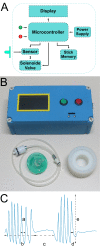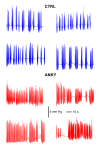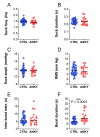Dysfunctional suction dynamics in newborns with ankyloglossia
- PMID: 39536166
- PMCID: PMC10727230
- DOI: 10.1590/2317-1782/20232023054
Dysfunctional suction dynamics in newborns with ankyloglossia
Abstract
Purpose: Compare infant suction in babies with and without ankyloglossia using a microprocessor-controlled pressure sensor coupled to a pacifier.
Methods: Fifty-five infants from 0 to 2 months of age underwent clinical examination for ankyloglossia, after which they were offered a silicone pacifier connected to the pressure acquisitiondevice and suction activity was recorded. Thus, we extracted the frequency of sucks within a burst, the average suck duration, the burst duration, the number of sucks per burst, the maximum amplitude of sucks per burst and the inter-burst interval.
Results: The key difference in newborns with ankyloglossia in relation to control was that they perform longer bursts of suction activity.
Conclusion: The longer burst durations are likely a compensatory strategy and may underlie the pain reported by mothers during breastfeeding. We therefore propose a method for objectively quantifying some parameters of infant suction capacity and demonstrate its use in assisting the evaluation of ankyloglossia.
Objetivo: Comparar a sucção infantil em bebês com e sem anquiloglossia usando um sensor de pressão controlado por microprocessador acoplado a uma chupeta.
Método: Cinquenta e cinco lactentes de 0 a 2 meses de idade foram submetidos ao exame clínico de anquiloglossia, em seguida foi oferecido uma chupeta de silicone conectada ao dispositivo de aquisição de pressão e a atividade de sucção foi registrada. Assim, obtivemos dados sobre a frequência de sucções dentro de um período de sucções, a duração média da sucção, a duração da rajada, o número de sucções por rajada, a amplitude máxima das sucções por rajada e o intervalo entre rajadas. O teste t não pareado foi utilizado para comparações entre os grupos.
Resultados: A principal diferença dos recém-nascidos com anquiloglossia em relação aos do grupo controle é que eles realizam rajadas mais longas durante a atividade de sucção.
Conclusão: A duração mais longa das rajadas é provavelmente uma estratégia compensatória e pode estar por trás da dor relatada pelas mães durante a amamentação. Portanto, propomos um método para quantificar objetivamente alguns parâmetros da sucção infantil e demonstramos seu uso para auxiliar na avaliação da anquiloglossia.
Conflict of interest statement
Conflict of interests: nothing to declare
Figures




Similar articles
-
The prevalence of ankyloglossia in 302 newborns with breastfeeding problems and sucking difficulties in Barcelona: a descriptive study.Eur J Paediatr Dent. 2017 Dec;18(4):319-325. doi: 10.23804/ejpd.2017.18.04.10. Eur J Paediatr Dent. 2017. PMID: 29380619
-
Changes in infant non-nutritive sucking throughout a suck sample at 3-months of age.PLoS One. 2020 Jul 9;15(7):e0235741. doi: 10.1371/journal.pone.0235741. eCollection 2020. PLoS One. 2020. PMID: 32645061 Free PMC article.
-
Application of Statistical Analysis and Machine Learning to Identify Infants' Abnormal Suckling Behavior.IEEE J Transl Eng Health Med. 2024 Apr 17;12:435-447. doi: 10.1109/JTEHM.2024.3390589. eCollection 2024. IEEE J Transl Eng Health Med. 2024. PMID: 38765888 Free PMC article.
-
When is the use of pacifiers justifiable in the baby-friendly hospital initiative context? A clinician's guide.BMC Pregnancy Childbirth. 2017 Apr 27;17(1):130. doi: 10.1186/s12884-017-1306-8. BMC Pregnancy Childbirth. 2017. PMID: 28449646 Free PMC article. Review.
-
Diagnosis, classification and management of ankyloglossia including its influence on breastfeeding.Dev Period Med. 2019;23(1):79-87. doi: 10.34763/devperiodmed.20192301.7985. Dev Period Med. 2019. PMID: 30954985 Free PMC article. Review.
References
-
- World Health Organization . Global strategy for infant and young child feeding. Geneva: WHO; 2003. [cited 2023 Feb 10]. United Nations Children’s Fund. Internet. Available from: http://apps.who.int/iris/bitstream/10665/42590/1/9241562218.pdf .
-
- Neu AP, Silva AMT, Mezzom CL, Busanello-Stella AR, Moraes AB. Relationship between time and type of breastfeeding and stomatognathic system functions. CEFAC. 2013;15(2):420–426. doi: 10.1590/S1516-18462012005000020. - DOI
-
- Knox I. Tongue tie and frenotomy in the breastfeeding newborn. Neoreviews. 2010;11(9):513–519. doi: 10.1542/neo.11-9-e513. - DOI
-
- Schwartz J. Identifying ankyloglossia in newborns at Paoli Hospital : a quality improvement project. Filadélfia: Drexel University; 2018. 72. [dissertation] - DOI
MeSH terms
LinkOut - more resources
Full Text Sources

